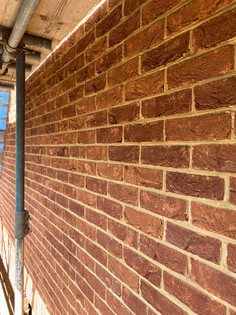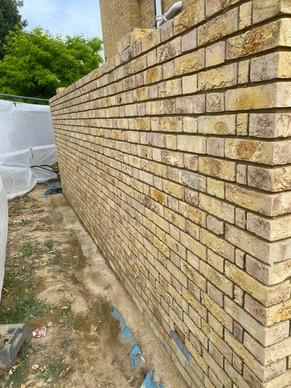🧱 Brickwork Tips: Choosing the Right Bricks, Maintenance, & Costs
- Andy Wood
- 1 hour ago
- 6 min read
Brickwork Tips & Advice | DJJ Projects Essex

Introduction: The Art and Science of Brickwork
Brickwork is the backbone of countless properties across Essex, Suffolk, and East London, defining not only a home’s strength and longevity but also its charm and character
From heritage terraces and barn conversions to modern extensions, brick choice and craftsmanship are vital to both structure and style
Yet, many homeowners underestimate how much brick type, mortar, and maintenance influence a property’s look, performance, and cost over time
Whether you’re planning a new build, an extension, or a restoration project, understanding the fundamentals of brickwork helps ensure your investment stands the test of time
At DJJ Projects, we’ve delivered hundreds of brick and block builds, from contemporary garden rooms to full home extensions, so we’ve seen how good brickwork can elevate a property
Here’s your complete guide to choosing, maintaining, and understanding the real value of quality brickwork
Choosing the Right Bricks
Selecting the right brick is one of the first and most important decisions in any building project.
Your choice affects appearance, durability, cost, and even planning approval in certain areas
Appearance and Style
Bricks come in a wide range of textures, colours, and finishes, from smooth modern engineering bricks to rustic reclaimed ones
When working on extensions or refurbishments, matching existing brickwork is key to achieving a seamless look
In areas like Chelmsford, Colchester, and Brentwood, where period architecture is common, planners often require close colour and texture matching
Tip: Always ask your builder for sample panels or mock-ups before finalising your brick choice
Natural light and mortar colour can dramatically change the overall tone once built
Durability and Weather Resistance
Different brick types perform differently depending on the environment
Engineering bricks are dense, durable, and excellent for damp-prone or structural areas
Fletton or London stock bricks, commonly seen across East London and Essex, are softer and require more care
Coastal areas like Suffolk or Kent often face salt exposure, so frost-resistant and low-absorption bricks are a safer choice
Expert insight: If you’re unsure, your builder can perform a freeze–thaw test or consult manufacturer data on water absorption and compressive strength
Sustainability and Reclaimed Materials
Sustainability is now a major factor in building material selection
Reclaimed bricks, often salvaged from demolished properties, are not only eco-friendly but add character and authenticity to period homes
However, reclaimed bricks can vary in size and condition, which makes them trickier to lay
A skilled bricklayer will account for these differences to maintain even joints and a consistent finish
DJJ Projects tip: Pair reclaimed bricks with modern lime-based mortar, it’s breathable, flexible, and ideal for heritage properties
Cost Considerations When Choosing Bricks
Brick prices can vary from £500 to £1,500 per 1,000 bricks, depending on type, colour, and finish
Special handmade or glazed bricks, often used for decorative work, can cost even more
Approximate costs (as of 2025):
It’s worth noting that brick choice impacts more than material cost, labour rates may increase for complex patterns, smaller formats, or restoration-grade projects
Brickwork Maintenance Tips
Even the strongest brickwork needs care over time
Weathering, pollution, and moisture can all affect appearance and integrity
Here’s how to protect your investment
Repointing
Mortar, the glue that holds your bricks together, naturally weathers faster than the bricks themselves
When joints start crumbling or gaps appear, repointing becomes necessary to maintain strength and weatherproofing
For homes in coastal Essex or urban areas like East London, repointing may be needed every 25–40 years depending on exposure
Use lime mortar on older properties, as it allows walls to “breathe” and move slightly without cracking
Pro Tip: Always hire an experienced mason, improper repointing (especially using hard cement mortar on older walls) can cause long-term damage
Cleaning Brickwork
Cleaning can restore the look of aged or stained brickwork, but it’s important to use the right method
Avoid pressure washing or harsh chemicals, which can strip the surface and cause moisture absorption
Safer methods include:
Soft washing using mild biocides
Steam cleaning (DOFF/TORC systems) for heritage projects
Manual brushing for delicate or lime mortar walls
DJJ Projects tip: Always test on a small area first, as some bricks react differently to cleaning agents
Preventing Damp and Decay
Damp is the enemy of good brickwork
Causes include poor drainage, blocked gutters, rising damp, or bridging at the base of walls
Preventative measures:
Keep gutters, downpipes, and drains clear
Ensure air bricks and weep holes remain open
Maintain ground clearance below damp-proof course (at least 150mm)
Use breathable, non-sealing paints or finishes
A regular inspection especially after heavy rain or frost, can prevent small damp issues becoming costly repairs
Repairing Cracks and Movement
Small cracks in brickwork aren’t always serious but should be checked
Common causes include settlement, expansion, or nearby trees drawing moisture
Repair approach:
Hairline cracks: Fill with lime-based mortar or colour-matched sealant
Larger structural cracks: May require stainless steel helical bars or partial wall rebuild
Always investigate cause before repair, fixing symptoms without addressing the issue can lead to recurrence
Cost Considerations and Project Planning
Understanding cost factors helps manage budgets and expectations from the start
Brickwork Labour Costs
In Essex and the surrounding areas, bricklaying typically costs between £500–£800 per 1,000 bricks, depending on complexity and access
Heritage or decorative work (e.g., arches, tuck pointing) can command higher rates, up to £1,000 per 1,000 bricks due to craftsmanship involved
Other influencing factors:
Site access and scaffolding needs
Type of mortar and bond pattern (e.g., Flemish, English, stretcher)
Waste disposal and preparation work
Budgeting for Repairs and Maintenance
For maintenance, expect:
Repointing: £40–£60/m²
Cleaning: £10–£25/m²
Crack repair: £150–£500 depending on severity
These are small investments compared to the potential cost of structural repair if issues are left untreated
Specialist Heritage Brickwork
In areas like Maldon, Dedham, and Saffron Walden, heritage or listed properties often require traditional lime mortars and handmade bricks
Though this can double the material cost, it’s crucial for compliance with conservation requirements and maintains the property’s integrity and value
Pro insight: Always check with your local planning authority before starting work on a listed building
Using modern cement or non-approved bricks can lead to enforcement notices or fines
Sustainability and Modern Brickwork Trends
Modern brickwork isn’t just about tradition, technology and sustainability are reshaping how we build
Energy Efficiency
Modern clay bricks provide excellent thermal mass, helping regulate indoor temperature
Combining quality brickwork with insulation and cavity barriers can significantly reduce heat loss
Reclaimed & Eco Bricks
Manufacturers now produce low-carbon and recycled-content bricks, offering the same strength with reduced environmental impact
Reclaimed brick suppliers in Essex and Kent make it easier to source materials locally, cutting both transport costs and emissions
Design Innovation
Contemporary architecture is reviving creative brick use, from perforated “hit-and-miss” walls for light and ventilation, to bold colour contrasts and geometric bonds
Brick remains timeless yet adaptable, bridging old craftsmanship with modern design
FAQs
Q: Can I use modern bricks on a listed building?
A: Usually no. Listed buildings often require approved, traditional materials and methods, check with your conservation officer first
Q: How long does good brickwork last?
A: With proper maintenance, well-built brickwork can last over 100 years
Q: When should I repoint my brickwork?
A: Typically every 25–40 years, or sooner if you notice loose mortar or visible gaps
Q: Are reclaimed bricks worth the cost?A: Yes, they offer unique character, reduce waste, and can even add value to period properties
Conclusion: Building to Last
Brickwork is both an art and a science, combining technical skill, thoughtful material choice, and regular maintenance
Choosing the right brick for your property, investing in quality craftsmanship, and caring for your walls will pay dividends in durability, energy performance, and curb appeal
Whether you’re planning a modern extension, restoring a Victorian terrace, or maintaining a listed property, DJJ Projects brings the expertise and attention to detail your home deserves
From brick selection to aftercare, we ensure every build is beautiful, functional, and built to last
Ready to start your project or need advice on brick selection and maintenance?
Get in touch today!


























Comments